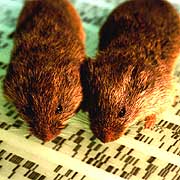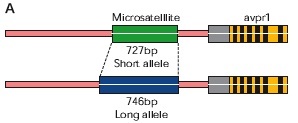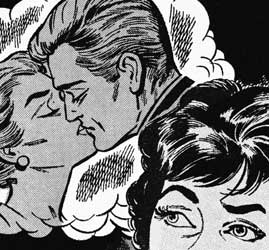High FidelityMonogamous behavior in mammalsMarjorie Nicholson & Kelsey Wood |
||
Ontogeny of monogamy in Prairie Voles
The Genetic and Environmental Influences on Monogamous Behavior
The social behavior of Prairie voles is very much a product of environment. This is shown through the variation of monogamy among the population. Although, in field studies, prairie voles are usually found in communal burrows with a single breeding pair, 45% of males and 24% of females do adopt a “wandering strategy” and do not settle down with a single partner (Nair and Young, 2006). This shows that, although an individual may have the genetic basis for monogamy, and possess the gene for it, they may not exhibit the behavior. This means that some unknown variable affects this behavior as much as genes do.
Pair Bond Formation as induced by Environment: It Takes Two to Tango
 |
Voles tangoing. Credit: USA Today |
Some other developing factors concerning monogamy involve finding that special someone with whom to form a pair bond. The Prairie vole needs to find a mate in its environment before monogamous behavior can occur.
Imagine this, once “introduced” to an unrelated male, a virgin female prairie vole begins to ovulate for the first time. They then mate with the male for 24-48 hours (if able to), and as a result of the mating they develop a pair bond. This attachment is usually life long, as if one partner dies, the remaining prairie vole will not accept a new mate in 80 percent of cases. (Nair and Young, 2006)
Wang et al. (2006) found that the pair-bonding hormone in the female, oxytocin (OT, see mechanism for more details) is released during sex and then influences her future behavior. Tests show that, if OT is given to her during exposure to a male, a partner preference can be induced without mating. Therefore, it is thought that the hormone associated with the act, and not the act of sex itself, that produces a pair bond formation. OT does not affect males in the same way. The most recent evidence suggests that, for males, the hormone arginine vasopressin (APV) seems to be the decisive element (Wang, 2006). Similarly to the experiment performed with OT, an introduction of AVP in the absence of mating is effective in causing pair-bond preference even in the absence of mating. Interestingly, an AVP antagonist blacks partner preference formation if given during mating (Insel and Young, 2007).
Thus, oxytocin and arginine vasopressin are present in both sexes, but they affect them differently. Similar to the hormones testosterone and estrogen, OT and AVP are found in both sexes and affect one sex more than the other. Thus, although identified as a "male" or "female" hormone, they aren't exclusively found in one gender alone.
Genetics of Pair-Bond Formation
 |
| Two common alleles for the avpr1 microsatellite region, which differ by only 19 basepairs, but cause changes in the brain and in behavior. Nair and Young. |
Individual variation in monogamous behavior of field-caught prairie voles may be due to genetic differences. The avp1r gene codes for the receptor for the hormone arginine vasopressin. There are two alleles for the avp1r microsatellite region, the long allele (746 bp) and the short allele (727 bp). The two alleles cause differences in the distribution of V1a receptors in the brain as well as in behavior. This distribution leads to behavioral changes as long alleled voles show stronger partner preference and more pup-licking behavior than short alleled males. (Nair and Young, 2006)
